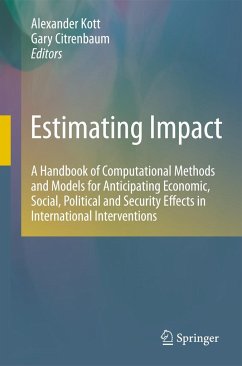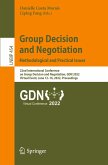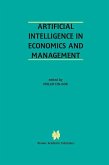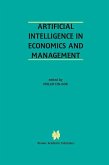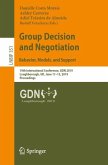Virtually all human endeavors can be analyzed and modeled and understood through computer-aided study, and that is very much at the core of operations research, game theory, and decision science.
Understanding the potential impact of any action is critical to the success of that action, and in ESTIMATING IMPACT Alexander Kott and Gary Citrenbaum, with a stellar group of contributors, demonstrate how military or humanitarian interventions (or the decision not to intervene) can be rigorously analyzed beforehand and their likely impacts and ramifications predicted at levels appropriate to their scope. A wide range of modeling programs are available that support plan assessment and impact forecast, and they allow accurate prediction within an interdependent set of political, military, economic, social, information, and infrastructure systems, and experts involved in the use and development of these tools demonstrate how, when, and why they should be used.
Sociological theories of crime include: theories of strain blame crime on personal stressors; theories of social learning blame crime on its social rewards, and see crime more as an institution in conflict with other institutions rather than as in- vidual deviance; and theories of control look at crime as natural and rewarding, and explore the formation of institutions that control crime. Theorists of corruption generally agree that corruption is an expression of the Patron-Client relationship in which a person with access to resources trades resources with kin and members of the community in exchange for loyalty. Some approaches to modeling crime and corruption do not involve an explicit simulation: rule based systems; Bayesian networks; game theoretic approaches, often based on rational choice theory; and Neoclassical Econometrics, a rational choice-based approach. Simulation-based approaches take into account greater complexities of interacting parts of social phenomena. Theseinclude fuzzy cognitive maps and fuzzy rule sets that may incorporate feedback; and agent-based simulation, which can go a step farther by computing new social structures not previously identified in theory. The latter include cognitive agent models, in which agents learn how to perceive their en- ronment and act upon the perceptions of their individual experiences; and reactive agent simulation, which, while less capable than cognitive-agent simulation, is adequate for testing a policy's effects with existing societal structures. For example, NNL is a cognitive agent model based on the REPAST Simphony toolkit.
Understanding the potential impact of any action is critical to the success of that action, and in ESTIMATING IMPACT Alexander Kott and Gary Citrenbaum, with a stellar group of contributors, demonstrate how military or humanitarian interventions (or the decision not to intervene) can be rigorously analyzed beforehand and their likely impacts and ramifications predicted at levels appropriate to their scope. A wide range of modeling programs are available that support plan assessment and impact forecast, and they allow accurate prediction within an interdependent set of political, military, economic, social, information, and infrastructure systems, and experts involved in the use and development of these tools demonstrate how, when, and why they should be used.
Sociological theories of crime include: theories of strain blame crime on personal stressors; theories of social learning blame crime on its social rewards, and see crime more as an institution in conflict with other institutions rather than as in- vidual deviance; and theories of control look at crime as natural and rewarding, and explore the formation of institutions that control crime. Theorists of corruption generally agree that corruption is an expression of the Patron-Client relationship in which a person with access to resources trades resources with kin and members of the community in exchange for loyalty. Some approaches to modeling crime and corruption do not involve an explicit simulation: rule based systems; Bayesian networks; game theoretic approaches, often based on rational choice theory; and Neoclassical Econometrics, a rational choice-based approach. Simulation-based approaches take into account greater complexities of interacting parts of social phenomena. Theseinclude fuzzy cognitive maps and fuzzy rule sets that may incorporate feedback; and agent-based simulation, which can go a step farther by computing new social structures not previously identified in theory. The latter include cognitive agent models, in which agents learn how to perceive their en- ronment and act upon the perceptions of their individual experiences; and reactive agent simulation, which, while less capable than cognitive-agent simulation, is adequate for testing a policy's effects with existing societal structures. For example, NNL is a cognitive agent model based on the REPAST Simphony toolkit.
From the reviews:
"Anyone involved in modeling or planning will want this excellent introduction. ... The book also includes a variety of case studies and examples. The editors provide several tables so that the reader may locate an example related to a mechanism of intervention, an effect of intervention, or a modeling technique. The references at the end of each chapter, as well as the index, are well done. ... an excellent introduction to the current field of modeling interventions, and will be useful and worthwhile to readers." (Brad Reid, ACM Computing Reviews, June, 2011)
"Anyone involved in modeling or planning will want this excellent introduction. ... The book also includes a variety of case studies and examples. The editors provide several tables so that the reader may locate an example related to a mechanism of intervention, an effect of intervention, or a modeling technique. The references at the end of each chapter, as well as the index, are well done. ... an excellent introduction to the current field of modeling interventions, and will be useful and worthwhile to readers." (Brad Reid, ACM Computing Reviews, June, 2011)

